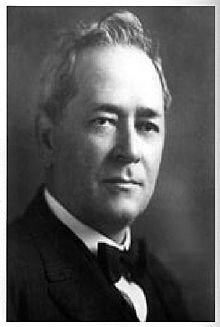Charles Haskell
| Charles Nathaniel Haskell | |
|---|---|
 |
|
| 1st Governor of Oklahoma | |
|
In office November 16, 1907 – January 9, 1911 |
|
| Lieutenant | George W. Bellamy |
| Preceded by |
Frank Frantz as Territorial Governor |
| Succeeded by | Lee Cruce |
| Personal details | |
| Born |
March 13, 1860 Leipsic, Ohio |
| Died | July 5, 1933 (aged 73) Oklahoma City, Oklahoma |
| Resting place | Muskogee, Oklahoma |
| Political party | Democratic |
| Spouse(s) | Lucie Pomeroy Haskell Lillian Gallup Haskell |
| Profession | teacher, lawyer |
| Religion | Methodism |
Charles Nathaniel Haskell (March 13, 1860 – July 5, 1933) was an American lawyer, oilman, and politician who was the first governor of Oklahoma. As a delegate to Oklahoma's constitutional convention in 1906, he played a crucial role in drafting the Oklahoma Constitution and gaining Oklahoma's admission into the United States as the 46th state in 1907. A prominent businessman in Muskogee, he helped the city grow in importance. He represented the city as a delegate in both the Oklahoma convention and an earlier convention that was a failed attempt to create a U.S. state of Sequoyah.
During Oklahoma's constitutional convention, Haskell succeeded in pushing for the inclusion of prohibition and blocking the inclusion of women's suffrage in the Oklahoma Constitution. As governor, he was responsible for moving the state capital to Oklahoma City, establishing schools and state agencies, reforming the territorial prison system, and enforcing prohibition.
Lee Cruce succeeded Haskell, who died of a stroke in 1933.
Born in West Leipsic, Ohio on March 13, 1860, Charles Haskell was the son of George R. Haskell, a cooper who died when the boy was three years old. His mother, Jane H. Reeves Haskell, worked for the local Methodist church as a bell ringer and custodian to support the six children. At the age of 10, he started working as a farm boy for a farmer named Miller in Putnam County, Ohio, where he lived and worked for eight years as he grew into adulthood. Miller was a school teacher, but as the young Haskell had to work, he did not have time to attend school. Instead, Miller's wife taught him at home and Haskell earned a teaching certificate at age 17.
Haskell became a teacher at age 18 and taught for three years in Putnam County. On December 6, 1880, he passed the bar exam, and became a practicing attorney at age 20 despite having no academic training in the field. In his work as an attorney, Haskell became one of the most successful lawyers in Ottawa, Ohio, the county seat, as well as one of the most prominent members of the Democratic Party in northwestern Ohio. In 1888, Haskell started work as a general contractor; for the next 16 years, his business career gave him an understanding of American industrialism. During this time, he lived in New York City and in San Antonio, Texas.
...
Wikipedia
